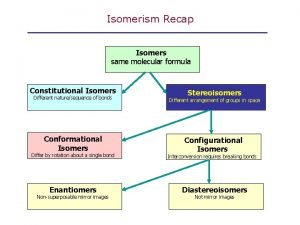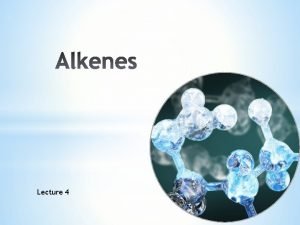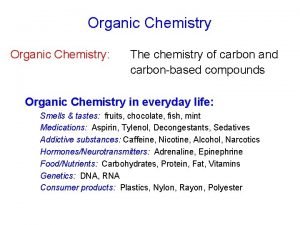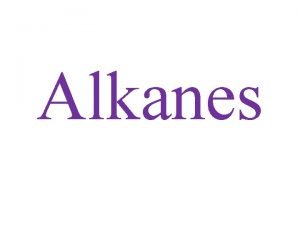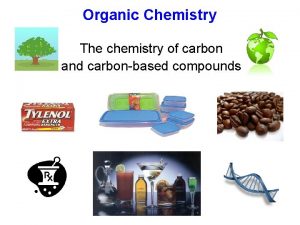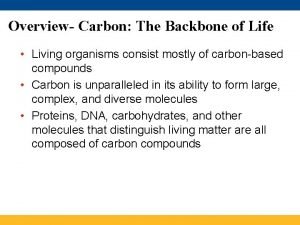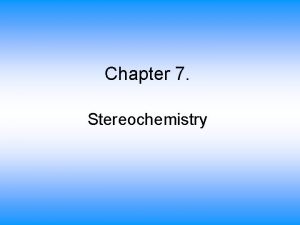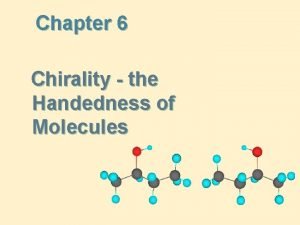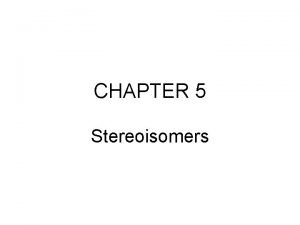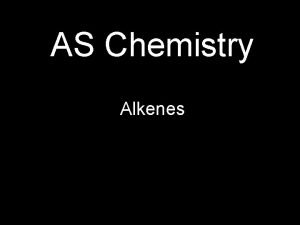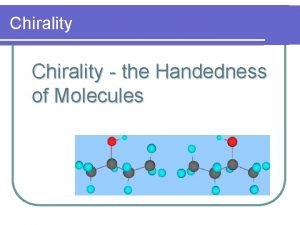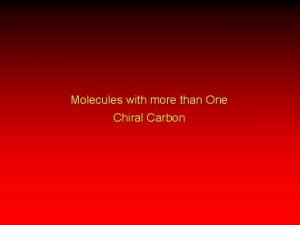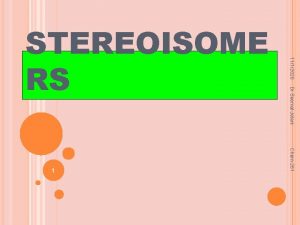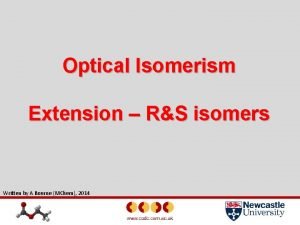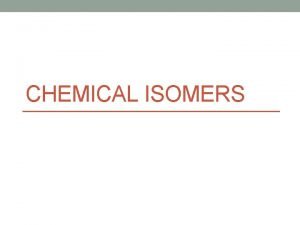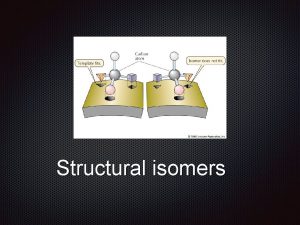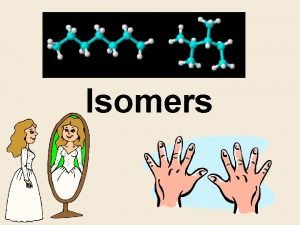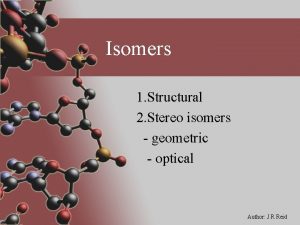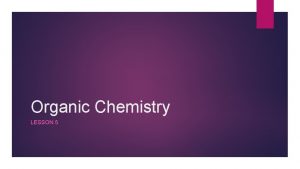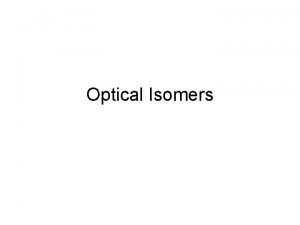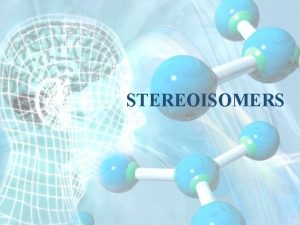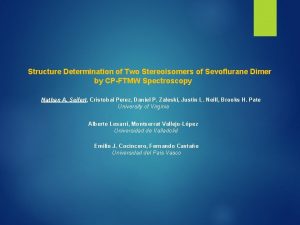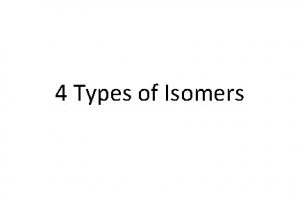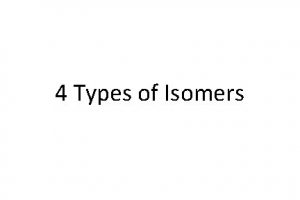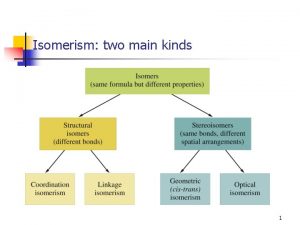Isomers Two types Structural isomers and Stereoisomers Structural





















- Slides: 21

Isomers Two types: Structural isomers and Stereoisomers Structural Isomers: Same atoms, different binding arrangements. A-B-C or C-A-B Let’s look at Butane and Methylpropane as an example

Isomers: Stereoisomers: The molecules are connected the same, but are arranged differently in space. There are 2 primary types of stereoisomers: 1) Geometrical Isomers: The atoms on either side of a bond are arranged differently 2) Optical Isomers: The molecules are each other’s nonsuperimposable mirror image

Geometrical Isomers A clear dividing plane gives the molecule a top half and a bottom half. If the arrangement of atoms is the same on either side of this plane, the molecule is the cis- isomer If the arrangement is different, the molecule is the trans- isomer

Geometrical Isomers Are these molecules cis- or trans- ?

Optical Isomers Go ahead and mentally rotate the molecules Do the Blue and Red spheres line up? It’s the same as trying to superimpose your left and right hands

Properties of Alkanes • Hydrocarbons are nonpolar – The only intermolecular force between adjacent hydrocarbons is the London Force • Methane through Butane are gases at room temperature

Properties of Alkanes • Long chain hydrocarbons have higher melting points than branched chains with the same number of carbons • Fatty acids in cell membranes take advantage of this to make themselves more fluid

Properties of Alkanes • • Parrafins are what alkanes were once called and you’ll sometimes hear the term used today – Means “Little Affinity” They got this name because they do not react with: Strong Acids Strong Bases Oxidizing Agents Why? – The bond enthalpies of the C-C and C-H bonds are so high Alkanes WILL undergo 2 types of reactions: 1. Combustion 2. Substitution: Some atom (say a halide) replaces a hydrogen on the hydrocarbon

Properties of Alkenes • The C-C double bond is more reactive than a single C-C bond – The electron density is more exposed above and below the plane of the molecule • The atoms can’t spin around the sigma bond • The double bond prevents molecules from packing as tightly – Lower melting points than similar alkanes

How do we make an Alkene? Elimination Reaction

Aromatic Compounds • Aromatic compounds are structurally based on the benzene ring • They are called Arenes – Aromatic alkene • Typically responsible for odors

Nomenclature of Arenes • We’ll start with benzene, C 6 H 6 – When benzene is a substituent, it is called a phenyl- group • We can use the number based system for naming the linear hydrocarbons Or • We can use an older system to describe the position of 2 substituents relative to each other

Nomenclature of Arenes • The positions of the benzene ring have unique names when dealing with 2 or more substituents • Ortho: Substituents are at positions 1 and 2 • Meta: Substituents are at positions 1 and 3 • Para: Substituents are at positions 1 and 4 Examples Dr. Hurlbert?

Chapter 19: Organic Chemistry II

Haloalkanes • A Haloalkane is an alkane that has had one of the hydrogens removed and replaced by a halogen atom – Also called Alkyl halides Properties: • Polar molecules • Other molecules with electron rich atoms (like oxygen) may attack the electron deficient carbon

Alcohols • When we put a hydroxyl substituent (-OH) onto an organic compound, we form an alcohol – As long as that organic compound isn’t benzene or the carbon isn’t a carbonyl carbon • Alcohols are named by adding the –ol suffix to the base name

Alcohols • Alcohols are liquids at room temperature – This is due to the hydrogen bonding capabilities given to them by the hydroxyl group • Low molecular mass alcohols (methanol, propanol) are soluble in water – Butanol and higher mass alcohols aren’t – Why?

Ethers • Who has heard of ethers before? – Used to be used as anaesthetics • Ethers have the formula R-O-R – Where ‘R’ is an alkyl group – The R’s don’t have to be the same • We can think of ethers as the next progression in moving from water to ethanol to ETHERS H-O-H CH 3 CH 2 -O-CH 2 CH 3

Ethers • Do not form hydrogen bonds. Why?

Ethers • • Are not very reactive Not very polar Flammable!! Over time, will form peroxides that will explode at the slightest energy input

Phenols • A Phenol is a compounds with a hydroxyl group attached to an aromatic ring • Unlike non-aromatic alcohols, phenols are weak acids, WHY? (Dr. H will draw something here) • Putting something in the way of the ring and the alcohol oxygen prevents the alcohol proton from becoming acidic
 Stereoisomer vs constitutional isomer
Stereoisomer vs constitutional isomer Types of stereoisomers
Types of stereoisomers Geometrical isomers
Geometrical isomers Difference between structural and geometric isomers
Difference between structural and geometric isomers Structural vs geometric isomers
Structural vs geometric isomers C5h12 structural isomers
C5h12 structural isomers Structure name
Structure name Constitutional isomers
Constitutional isomers 3 methylhexane
3 methylhexane Structural isomer
Structural isomer 2,3-dichlorobutane
2,3-dichlorobutane 2 3-dichloropentane stereoisomers
2 3-dichloropentane stereoisomers 2 3-dichloropentane stereoisomers
2 3-dichloropentane stereoisomers Stereoisomers always possess handedness.
Stereoisomers always possess handedness. Mirror image stereoisomers are called
Mirror image stereoisomers are called Alkene stereoisomers
Alkene stereoisomers 2 3 4-trihydroxybutanal stereoisomers
2 3 4-trihydroxybutanal stereoisomers Hexaldose
Hexaldose Meso-1,2-cyclopentanediol
Meso-1,2-cyclopentanediol Decorative design patterns
Decorative design patterns Stylized decorative design
Stylized decorative design R and s isomers
R and s isomers
